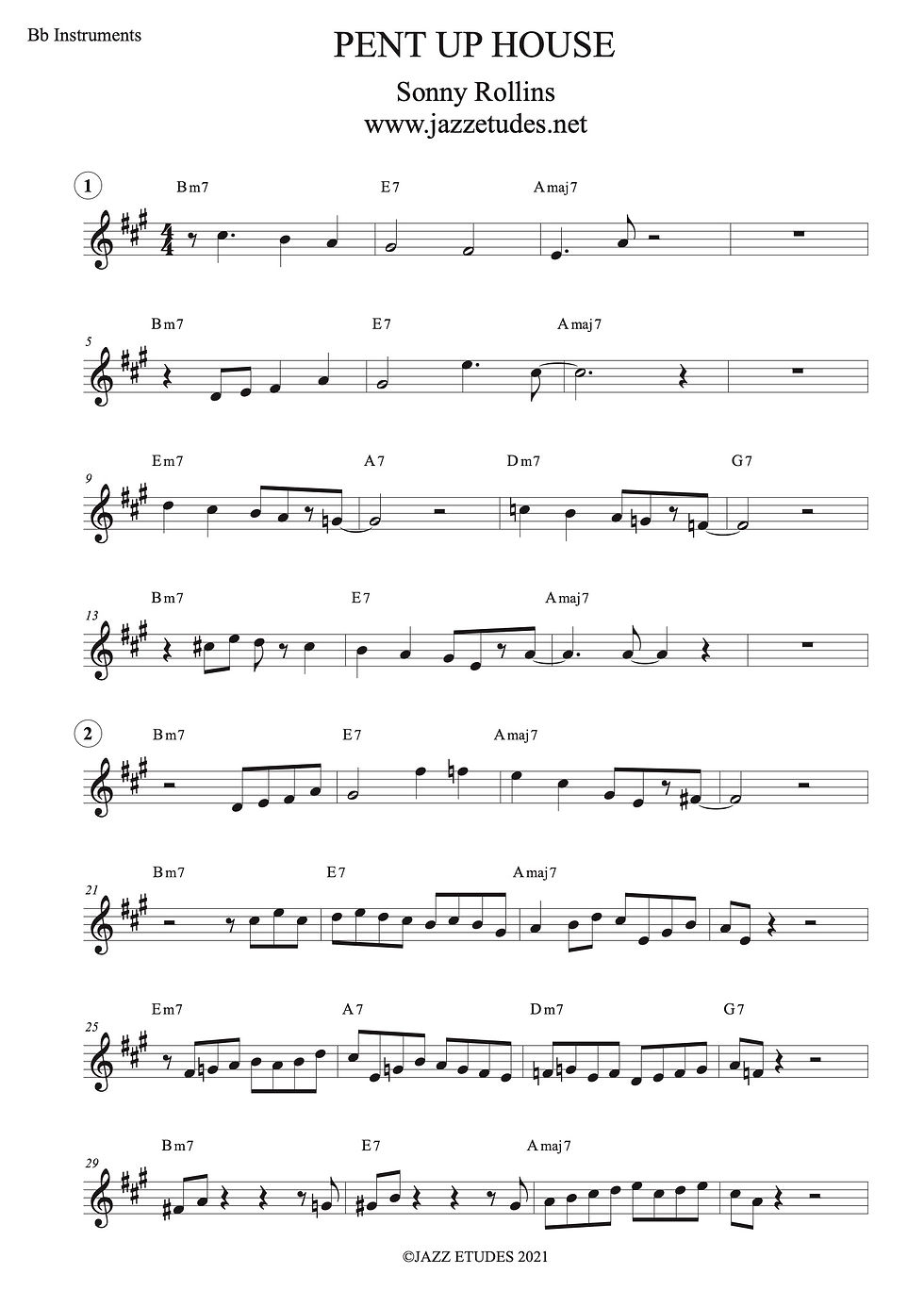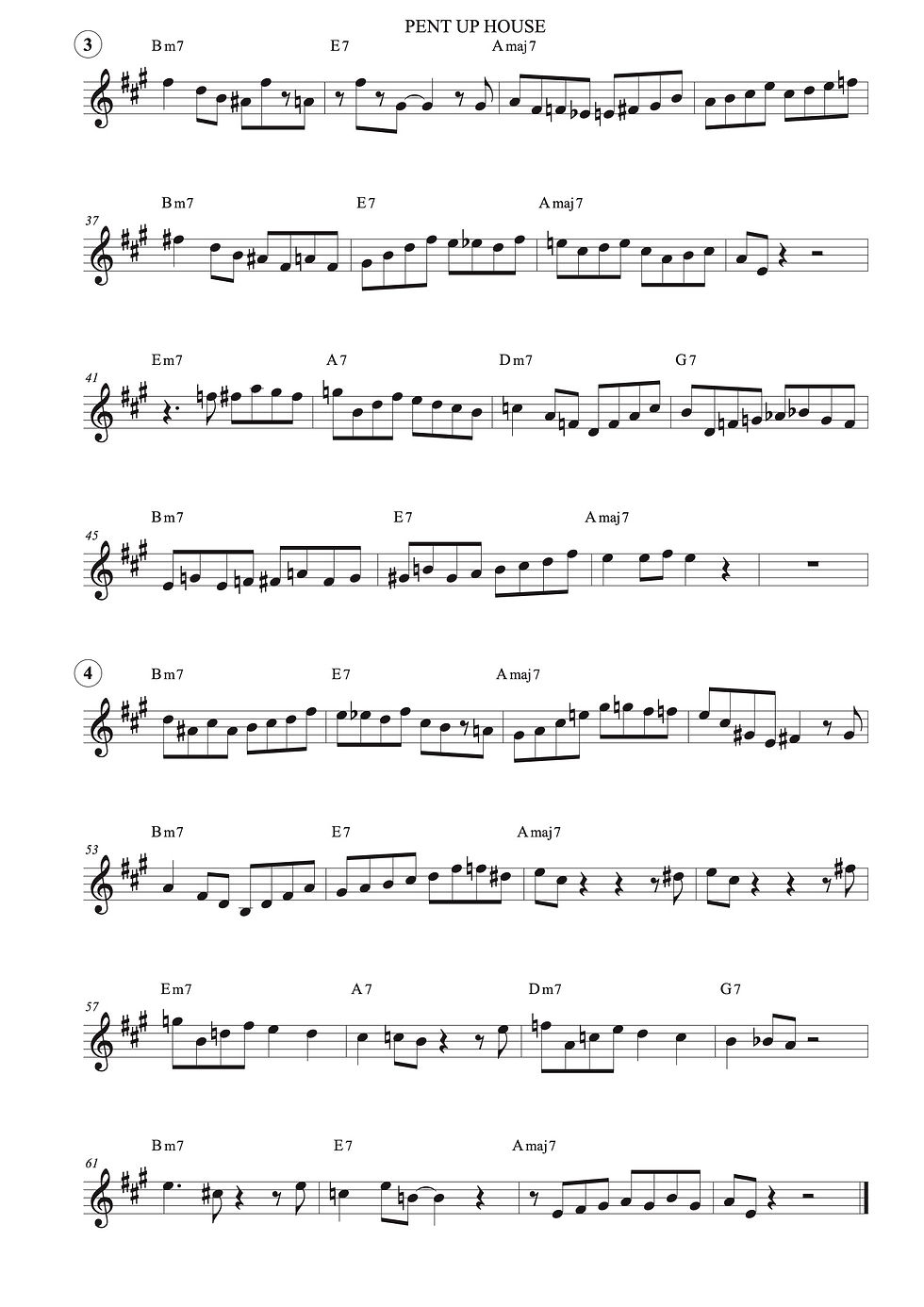How to practice II V I's
- Darren Lloyd
- Sep 23, 2023
- 5 min read
Hi guys, in this post I will teach you a couple of ways to practice II V I's in a meaningful way that will (hopefully) have a lasting impact on your actually playing rather than just trying to remember a bunch of licks!
First of all, what is a II V I?

Here you can see a D minor 7 chord followed by the G7 chord and ending in a C major 7 chord.
Now take a look at this image

Each chord has been given a roman numeral number. One through to 7.
So, a two, five, one is Chords 2 5 & 1 or II V I.
All of the chords are in the key centre of C major in the image.
That is a II V I.
Here are the same chords but in the key of D major -

So you can see here that the II V I would be -
Em7 / / / | A7 / / / | Dmaj7 / / /|
2 5 1's or sometimes just the 2 5 are found on many occasions in jazz standards.
Here is the lead sheet for the tune 'Pent up house' by Sonny Rollins.
The key I am showing is in Bb pitch!

In the image you can see that bars 1 - 4 is a II V I in the key of A major, the same with bars 5 - 8.
Bars 9 - 10 is a II V in the key of D major and bars 11 - 12 are a II V in the key of C major.
Bars 13 - 16 reverts back to a II V I in the key of A major.
So, in Pent up house, there are three key centres that as a jazz soloist we need to navigate. This is why it is important to know your instrument very well in multiple (preferably all) keys.
Check out this image, here I am showing you the chord changes as well as the roman numerals underneath the chord changes!

Hopefully this all makes perfect sense!
Some jazz standard are packed full of II V I's.
Take a look at the lead sheets for tunes like All the things you are, Tune up, Autumn leaves, Cherokee...
For this blog post I will focus only on Pent up house.
So, the title of this blog is How to practice II V I's. So, how can we? Without having to be a virtuoso musician.
One of my favourite jazz musicians is the great Clifford Brown. In fact, check him out here playing on this tune, Pent up house.
Someone has done a great job in transcribing his solo for us to check out!
Now Clifford is a virtuoso and as such, for us mere mortals, his transcribed solos can be incredibly difficult for us to master. This in fact is one of his more accessible solos but it's still tricky!!!
So, you could copy a whole bunch of Clifford licks and try to remember them, or you could practice Clifford's or any other of your favourite players jazz vocabulary in much smaller chunks and internalise that instead. For me, that has proved to be a much more accessible way!
Before we get to that though, it is very important to have internalised the chord changes!
I am going to assume you know your chord changes by now.
This practice suggestion focuses on the guide tones! The 3rd and 7th of each chord change.

The above image shows both the 3rd and 7th with the 7th on top.

Again, the above image shows both the 3rd and 7th but this time the 3rds are on top.

This image shows only the 7ths, practice targeting the 7th!

This image shows only the 3rds, for me the 3rd is the most beautiful sounding melodic note and always the first I strive to internalise.

This shows 7th to 3rd to 7th.

This shows 3rd to 7th to 3rd.
Experiment with these exercises and see which is the most pleasing to your ears!
Practicing in this manner will help you to really hear the changes. Some people say, just play around the tune. That is okay if the tune is simple but what if you are playing a tricky bebop head or Pent up house?
This is the functional harmony of the II V I. The 7ths going to the 3rds and the 3rds going to the 7ths.
If you have one, try it on piano. Play the root of each chord in your left hand and try the examples shown in your right hand.
If you are just trying to remember a bunch of licks, in the long run (for me at least) you will never feel like you are really improvising. You will just be remembering.
Practicing this way gives you are great insight how the actually change happens.
Check out this next example.
Once you have target notes internalised into your ears (feel free to also use a lead sheet if you can't quite internalise them yet) we need to start practicing vocabulary. The bits in between the target notes!
So, check out the exercise below.

In it, it requires you to just focus on the 3rds.
Once you can do this, try and approach the target notes from below by three 1/8 notes, if that is too tricky straight away, try and start with one, then two and then the three! This gives you a great feeling of forward motion once mastered! I highly recommend Hal Galpers great book called FORWARD MOTION.
I think you will be surprised at how melodic just this exercise sounds!

Next, try to target the 3rds again from three 1/8 notes from above! Again, if too tricky at the start, try just one and then two!

Again, it will sound very melodic and also give you the first steps to creating beautiful flowing lines.
Next, try to fill out the first part of each bar as shown in this demo.
You could think of targeting the tonic of each chord on beat three if it helps!

Then try from below!

If you tried this and also mixed in chromatic enclosures, you could really srtat to sound authentic by just using two types of vocabulary without everr having to try and remember anyone's licks! Just their vocabulary. For more insight into chromatic enclosures, check out this blog post!
So, next, we look at some other different types of vocabulary!

This is what I call a 'Fats Navarro' enclosure. Simply because it was the forst time I ever heard it! It is beautiful vocabulary and sounds super authentic!
Remember, you are reading this blog post in super quick time but to get this vocabulary into your ears and fingers will take many, many, many hours of super focused practice!
What I love about that type of practice though is it takes all the guess work out of practice jazz and gives you something super authentic to aim for.
Here is another idea to try and get some authentic vocabulary into your playing, it's the sort of line you might hear Chet or Tom Harrell maybe play!

Here are some more vocabulary ideas to practice over a II V I, again, much of this vocabulary will work on any chord and not just the one shown here!

I could go on and on wiritng sample exercises using small chunks of vocabulary but I am sure by now you get the idea of where I am coming from.
Here is a progressive jazz etude I created a while ago on Pent up house for you to try.
You will see it is full of the following vocabulary.
Chord notes
Syncopation
Motifs
Enclosures
Chromatic enclosures
Approach notes
Fats Navarro enclosure
Tom Harrel lick
Some covered in this post, some covered in upcoming posts.


I hope this blog post has helped you in some small way!
If you would like to work closer with me, I have the following ways -
Jazz coaching program - Free training video - Links through to the option of chatting with me if interested in my coaching.
Jazz lessons via Patreon - Monthly live lesson and a catch up zoom call at end of the month. Also an option to have your solos reviewed.
Warm regards, Darren.
As always, feel free to comment below, share the post and join the jazz etudes newsletter where I will send you some freebie jazz etudes and resources!
Darren.



Excellent presentation, encouraging to put in the work
First rate coaching! Thanks so much Darren. Giant steps towards playing like Clifford Brown! Well, given time!
100%1 valuable info!